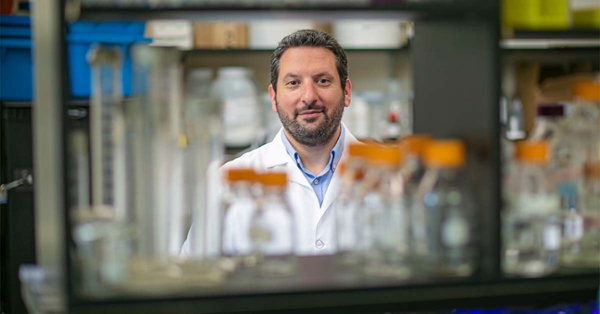Solutions to the opioid crisis are ‘around the corner’
Solutions to the opioid crisis are ‘around the corner’

Well before prescribers firmly understood the addictive power of opioids, Rich Jermyn, D.O., knew something was terribly wrong.
A pioneer in pain management and addiction medicine, Jermyn treated chronic pain among HIV/AIDS patients in his clinic at what is now Rowan-Virtua School of Osteopathic Medicine (SOM) in Stratford. He knew his patients well. So, when many developed an ever-increasing need for the opioids he was prescribing, he recognized two things: The medications weren’t as safe for long-term use as its makers had advertised. And the fallout would require an immense effort to repair. 
The opioid epidemic has since claimed people across every age, race and socioeconomic demographic. Even as opioid prescriptions have plummeted, deaths due to opioid use disorder (OUD) have continued to soar in the United States as powerful synthetic fentanyl flows into the illegal market, accounting for 75 percent of drug overdose deaths in 2021 alone.
“Substance use disorder will never get better until we start looking at addiction as a disease like diabetes and hypertension,” said Jermyn, dean of Rowan-Virtua SOM and founder of its NeuroMusculoskeletal Institute (NMI), both in the Virtua Health College of Medicine & Life Sciences.
“It's just a new HIV from a stigma perspective,” said Jermyn. “The reason opioid addiction isn't being treated better than it is right now is because people think it's a moral failing. It's not. It's a mental health disease and we have treatments for it.”
To address the crisis, researchers and physicians across Rowan University’s campuses are working with partner health systems to discover new treatments, train the next generation of providers and find new strategies to help people access treatment and recover. Below is just a sample of the research underway.
The work, Jermyn said, is mission-critical.
New frontiers
Researchers in the Department of Cell Biology & Neuroscience at the Rowan-Virtua School of Translational Biomedical Engineering & Sciences and the Rowan-Virtua SOM are working to map the brain mechanisms involved in opioid-reward and opioid-seeking behaviors, information that could one day lead to the development of new treatments, therapies or prescribing practices.
Early work by behavioral neuroscientists Dan Manvich, Ph.D., and Jessica Loweth, Ph.D., has shown that both drug reinforcement and drug craving for prescription painkillers varies during the rodent reproductive cycle, an understudied area of addiction research they hope to explore further.
“There are findings that, generally speaking, females might be more sensitive to certain aspects of addiction than males,” Loweth said.
Specifically, fluctuating hormones across the reproductive cycle are known to influence craving and relapse. Loweth’s work focuses on how ovarian hormones may affect receptor signaling within the neuronal reward circuitry. Such information could help identify therapeutic targets to reduce craving and promote abstinence in recovering users.
In another line of inquiry supported by the New Jersey Health Foundation, Manvich is collaborating with researchers at the National Institute on Drug Abuse (NIDA) to understand how new compounds for the treatment of opioid use disorder are able to reduce the effects of opioids in the brain.
“If we can understand how these drugs are exerting their therapeutic effects,” Manvich said, “then we can design improved compounds that do it best—optimally maximizing the beneficial effects and minimizing the unwanted side effects.”
Stress, anxiety could affect susceptibility
Stress neurobiologist Dan Chandler, Ph.D., explores how the brain responds to stress and how the brain, specifically the area called the locus coeruleus, generates anxiety in response to stress.
The brain’s naturally occurring opioids, primarily endorphin and enkephalin, bind to receptors in the locus coeruleus, calming anxiety. Chronic stress decreases the levels of opioid receptors in that part of the brain and could prime the brain for a more permanent state of anxiety. As part of a NIDA-funded research collaboration, Chandler and Manvich are studying the effects of opioids on a stressed brain.
“Because stress reduces the brain’s ability to respond to natural opioids, these more potent abused opioids might become more rewarding because they’re reducing the anxiety that’s caused by stress,” Chandler said. 
Through NIDA-funded rodent studies, behavioral neuroscientist Elizabeth West, Ph.D., is building on her research on cocaine and decision-making to determine if opioids impair decision-making abilities. She’s also examining whether an individual’s decision-making behavior can predict elevated opioid use.
“I’m interested in susceptibility, vulnerability and resiliency,” West said.
Ultimately, researchers hope to find a method for determining which patients are at higher risk of developing opioid use disorder.
Taking it to the street
It’s one thing to have treatments available. It’s another to get them to the people who need them most.
“You’ve got to meet the patients where they're at,” said Jermyn. “That includes addiction.”
As part of its mission to treat the underserved, Rowan-Virtua SOM uses $22 million in extramural funding largely to reach marginalized populations and find creative ways to address health care disparities in southern New Jersey.
During the COVID pandemic, for example, Jermyn marshaled a mobile unit to deliver Suboxone to people with opioid use disorder and COVID vaccines to unhoused populations.
Other grants support suicide prevention among veterans; “train the trainer” programs to promote the use of Narcan in communities with high rates of opioid overdoses; and virtual courses to teach New Jersey doctors how to manage opioid-dependent patients.
“We’re not only treating the substance use disorder, but we’re actually treating the patient,” Jermyn said. “This might be the first time that they’ve had any medical evaluation. And we find a host of chronic conditions that are being untreated.
“This is why we’re out in the community,” Jermyn said. “It’s boots on the ground.”
‘Fast and furious’
While synthetic opioids like fentanyl have accounted for the majority of drug overdose deaths in recent years, adulteration of fentanyl with the animal tranquilizer xylazine has emerged as a major public health concern that is complicating resuscitation and recovery options.
But investigators aren’t giving up.
“A particular challenge with xylazine-containing fentanyl is that Narcan seems to be less effective for counteracting overdose, but the research is coming fast and furious,” said Manvich, who is closely following studies characterizing the effects of xylazine-fentanyl combinations.
“There are a lot of outstanding researchers working to address these questions,” he added. “As long as the NIH has a healthy budget and continues to fund the research, I do really believe that novel medications and improved treatment strategies are around the corner.”